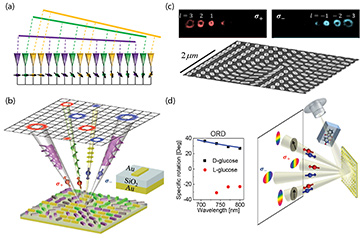 (a) The shared-aperture concept. (b) Multiple OAM wavefronts emerge from an interleaved GPM based on gap-plasmon nanoantennas. (c) Scanning electron microscope image of a fabricated harmonic-response GPM, with the measured spin-dependent harmonic OAM diffraction orders (l, topological charge) at λ = 760 nm. (d) Measurement setup for the SPM. When illuminated by polychromatic light passing through a sample, four beams of different polarization states (right and left circular polarization, σ+ and σ–, and linear polarization projection at 0° and 45°) are then reflected towards a CCD camera. Chart shows ORD for specific rotation of glucose enantiomers measured by the SPM, with the D-glucose ORD literature values in blue.
(a) The shared-aperture concept. (b) Multiple OAM wavefronts emerge from an interleaved GPM based on gap-plasmon nanoantennas. (c) Scanning electron microscope image of a fabricated harmonic-response GPM, with the measured spin-dependent harmonic OAM diffraction orders (l, topological charge) at λ = 760 nm. (d) Measurement setup for the SPM. When illuminated by polychromatic light passing through a sample, four beams of different polarization states (right and left circular polarization, σ+ and σ–, and linear polarization projection at 0° and 45°) are then reflected towards a CCD camera. Chart shows ORD for specific rotation of glucose enantiomers measured by the SPM, with the D-glucose ORD literature values in blue.
Multifunctional planar systems that perform multiple concurrent tasks in a shared aperture have recently emerged in phased-array antennas for radar applications.1 The shared-aperture phased antenna array promises increased functionality in planar photonics as well. Metasurfaces consisting of subwavelength nanoantennas can manipulate light by controlling the local amplitude and phase of an incident electromagnetic wave.2–4 Effective control of the metasurface’s electromagnetic response can be acquired through the geometric-phase mechanism, which enables spin-controlled phase modulation—the photon’s spin being associated with the intrinsic angular momentum of light.2,4
We have incorporated the shared-aperture phased-antenna-array concept and the geometric-phase mechanism, using spin-orbit interactions, to implement a multifunctional geometric-phase metasurface (GPM).5 Using this approach, we realized a high-efficiency multifunctional GPM, with independent control of the phase and polarization distributions of each wavefront. We adopted a thinning technique within the shared-aperture synthesis and investigated interleaved sparse nanoantenna matrices and spin-enabled asymmetric harmonic response. This allowed us to achieve spin-controlled, multiple structured wavefronts, such as vortex beams carrying orbital angular momentum (OAM).
Multitasking GPMs are under development for real-life applications, such as enantiomeric distinction of chiral organic molecules, a problem with wide applicability in the pharmaceutical and food industries. We have created a novel device for the simultaneous determination of the polarization state and spectrum of light, which we call a spectropolarimeter metasurface (SPM), that is based on interleaved GPM. The SPM device enabled measurement of the optical rotary dispersion (ORD) of L-glucose and D-glucose, and thus allowed us to characterize and differentiate between those two enantiomers. (Such distinctions are important; mammals, for example, have enzymes that break down D-glucose as oppose to L-glucose, so only the D enantiomer is biologically active.)
The alliance between geometric phase and shared-aperture antenna arrays paves the way for spin-enabled, multifunctional wavefront shaping using a single broadband nano-optic device.
Researchers
Elhanan Maguid, Igor Yulevich, Dekel Veksler, Vladimir Kleiner and Erez Hasman, Technion–Israel Institute of Technology, Haifa, Israel
Mark L. Brongersma, Stanford University, Stanford, Calif., USA
References
1. R. L. Haupt. IEEE Trans. Antennas Propag. 53, 2858 (2005).
2. Z. Bomzon et al. Opt. Lett. 27, 1141 (2002).
3. A. Pors et al. Sci. Rep. 3, 2155 (2013).
4. D. Lin et al. Science 345, 298 (2014)
5. E. Maguid et al. Science 352, 1202 (2016).
